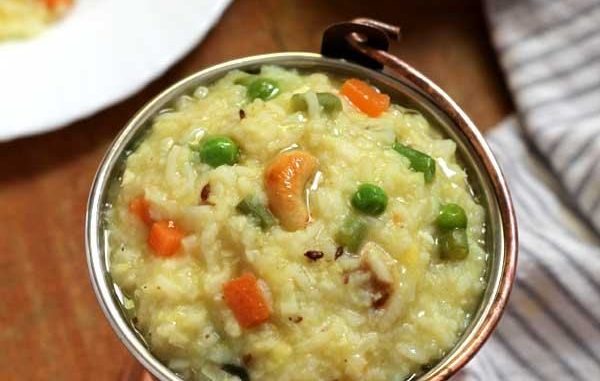
There are times when your body and spirit hunger for a kind of sustenance that’s not only simply fueling your stomach but also grounding, healing, and calming you from the inside. Vegetable Pongal is just that. A soft, spiced rice and lentil porridge that is originally from Tamil Nadu but enjoyed entirely throughout India for its wholesome simplicity. It’s a feeling and not just a dish, but one that incorporates turmeric, ginger, and black pepper and is enriched with ghee. They say it is a perfect comfort meal; with the addition of vegetables, it becomes a nutritious, balanced meal.
Why is Pongal So Unique?
It is the South Indian counterpart of Khichdi, but the flavor profile is very different. The spices used are based on black pepper, cumin, ginger, and ghee.
Important Points about Vegetable Pongal
- One pot—easy to clean,
- Soft porridge-like texture—easy to digest,
- Balanced—Protein + Carbohydrates + Vegetables + Fats
- Comforting yet deeply flavored
- Easy to veganize (substitute ghee for oil)
- Good for babies, the elderly, and those with delicate digestive systems
Ingredients—What You’ll Need
- ½ cup of yellow moong dal (split mung lentils)
- ½ cup of uncooked rice (short-grain type like sona masoori or basmati if needed)
- 3½ to 4 cups of water
- ½ tsp of turmeric powder
- Salt to taste (almost 1¼ tsp)
- Optional: A dash of asafoetida (hing)—for digestion
- Vegetables (customizable):
- ¼ cup diced carrots
- ¼ cup chopped French beans
- ¼ cup green peas (fresh or frozen)
- Optional: sweet corn, potatoes, or bottle gourd (lauki)
- Tadka (Tempering):
- 1½ tbsp ghee (or coconut/oil for vegan)
- 1 tsp cumin seeds
- 1 tsp of whole black peppercorns, coarsely crushed
- 1-inch piece of ginger (grated or finely chopped)
- 8-10 curry leaves
- 10-12 cashew nuts (for texture and richness)
- Optional: 1-2 green chilies for heat.
The type of food and dish that is used as a ritual offering to the deities, made during the festive season of Pongal, and eaten when someone is sick or recovering from an illness.
And most importantly? A dish that asks nothing from you and rewards you with so much in return. Making Perfect Vegetable Pongal (Step by Step)
- Wash, Soak (optional), and Prep
- Wash the rice and dal 2-3 times, or until the water is clear.
- If you can, soak the rice and dal together for about 10-15 minutes, which will help them cook faster and more evenly and properly.
- Chop your vegetables into small pieces and keep them close by.
- Cook the Rice, Dal & Veggies Together
- In a heavy-bottomed pot or pressure cooker,
- Add the soaked rice & dal, turmeric, salt, and 3½ – 4 cups of water.
- Add in the chopped carrots, beans, peas, or whatever veggies you want.
- Mix everything together and then close the lid.
- Pressure cooker—Cook for 3-4 whistles at medium heat.
- Pot—Bring mixture to a boil, then cover and simmer for 30-35 minutes at low heat, stirring occasionally.
- You want the final texture of the pongal to be mushy, creamy, and mixed together (it should be similar to a risotto or congee).
- Prepare the Tadka (tempering).
- While the rice & dal are cooking:
- Put the ghee into a small pan and heat.
- Add the cashew nuts and roast until golden—set aside for garnish.
- Next, add the cumin seeds and coin-sized, coarsely crushed black pepper into the same ghee.
- Once they splutter, add in the ginger and chopped green chili.
- 4. Combine and Serve
- After the Pongal has been cooked, open the cooker and, with a spoon, gently mash or mix with the back of the spoon.
- If the Pongal is too thick, add a few tablespoons of hot water. The consistency should be soft and spoonable.
- Pour the hot tadka over the Pongal and gently mix it through.
- Top with the fried cashews and, if you wish, a little puddle of ghee (this step is optional but really yummy!).
What to Serve with Vegetable Pongal
Though it stands well on its own, one of the great things about Pongal is you can create a simple, temple-style comfort plate. In case you want to add to it, here’s how you’d build your plate:
- Accompaniment: Why Add It?
- Coconut chutney Creamy and cooling—balances the heat from pepper
- Sambar adds tangy flavor and vegetables.
- Curd/Yogurt: Soothing and probiotic
- Papad or Vadam Adds crunch and texture contrast
- Lemon pickle A little dollop elevates everything.
Health Benefits
- Moong Dal – A great source of easily digestible protein, high in iron and B vitamins.
- Rice – A good source of carbohydrates for energy; when combined with dal, it forms a complete protein.
- Vegetables – Provide fiber, vitamins, and antioxidants.
- Black Pepper & Ginger – Help boost immunity and support digestion.
- Ghee – Provides healthy fats, beneficial for gut health and joints (in moderation).
Ayurveda Tip: Pongal is best for balancing the Vata & Kapha doshas seeing as it is gently spiced and made of easy-to-digest foods, ideal for rainy or cold months.
Variations—Make it Your Own
For variation, you can make Millet Pongal by replacing rice with foxtail millet for more fiber and better glycemic control, or prepare a Vegan Pongal by using cold-pressed oil instead of ghee. For extra heat, try a Spicy Pongal with diced green chillies or a sprinkle of crushed red chilli powder. To boost protein, stir in boiled green gram sprouts or diced tofu. If you prefer something even lighter, make a Plain Pongal without vegetables for a soothing, simple version. This dish keeps well in the fridge for 2–3 days, and to reheat, simply add hot water or milk, stir, and warm gently on the stove or in the microwave. It is also ideal for lunchboxes, babies, and elders, with spice levels adjusted as needed.
Final Thought:
Vegetable Pongal does not have any bells and whistles. It does not try to put on a show. Yet, it appears when you need it the most—warm, comforting, and full of love. Whether you are sick, in a pinch for time, or just in the mood for something comforting, this is a dish that quietly says, “It’s going to be alright.”

Leave a Reply